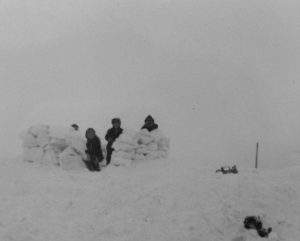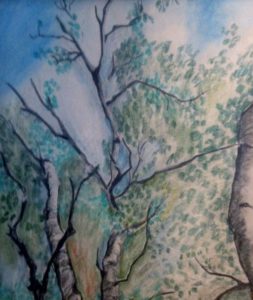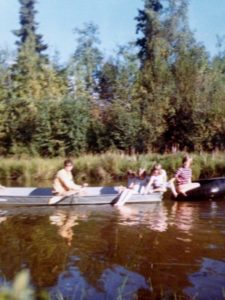
Arctic Fort – family album
The ink of memory
As I write my way into Lou’s world I revisit the rituals of fort building. Snow fortresses involved battle strategy. Any structure constructed in winter was short-lived, prone to cave-ins and conquest, subject to warming trends carried on the balmy currents of a Chinook. Most of our winter wars were half-hearted and never decisively concluded. No one won or lost entirely. We just all got very cold and gathered after wards for the very best of truces those made over hot chocolate.

Matanuska-Susitna sketchbook
Spring Rituals of fort building
Spring forts were built opportunistically. Junk lumber, old plywood sheets, material relegated to the burn pile: all suggested possibilities. Once, my friend and I discovered that a road crew had downed some spruces on the boundary of my parent’s land. Two sawhorses and many hours of cutting and peeling away branches resulted in my first woven fort. Shortly after our efforts at creating a dome of inter-laced branches was concluded it started to rain. The fort was dark, cozy, and water proof. That very fort found its way into TAPPING LIGHT. Because a fort that well executed deserves to be reincarnated.
My Moon or Bust fort was essentially a plywood box with a flap and outfitted with old tires and the guts from a discarded radio. The knobs and dials inserted into a cardboard control panel added just the right effect. The countdowns always resulted after some overwhelming disaster was right on the verge of destroying Earth. Forever. Climbing in and out of the Moon or Bust fort always felt a bit like climbing into and out of a bomb shelter.
Then there was the elevator-to-hell fort – one of my all time favorites. My brother and I used a lock and tackle to hoist up a heavy wood platform, tying it onto the trunks of four slender birch trees. This was such an improbable plan that when we got it to work we jumped up and down in celebration. The whole thing plummeted to the ground with us on board. Shrieking, we tumbled to the ground. And wondered if we could do it all over again.
How did we survive those spring rituals of fort building? We never broke any bones. I do, however, recall a few butterfly bandages and more than one tetanus shot.

family album
Loon shit paradise
My parents had a small amount of acreage in the city limits. The house perched on a hill that in my childhood perceptions seemed as steep and magical as the glass mountain of fairy tales. At the base of the hill a small muck-bottomed pond was temporary home to ducks and geese and a permanent base for a surly muskrat who did every thing in his power to avoid us, a host of small fish and flotillas of water beetles.
It was paradise. That pond proved to be a kind of challenge to my brother, who was three years older than me. While I spent long summer days reading and bobbing over its surface on an inner tube, he felt compelled to test his three speed bike against the power of water and pond muck. His goal: to take the hill with such speed and accuracy as to be able to launch into the pond and somehow pedal across its width. He never succeeded but numerous passersby and neighbors got to, as he would say, laugh their asses off.
One fine summer day, long after school was a distant though haunting memory, and it seemed as if July would never end, he decided that if he couldn’t set a record for biking through pond muck, we could build a fort. A fort on the pond. At first I thought he meant a raft with a tent or maybe a lean-to on a short dock. No.
The Titanic in three feet of water
Pond muck, or as our father called it loon shit, was deep and unpredictable. We had to fill sandbags, then haul them out to the center of the pond. We had a surplus of canvas army bags in the basement. One of our summer jobs was to shore up the bank where a culvert ran out of our pond and into a creek that winded through cottonwood trees and the neighborhood beyond the road.
Next, we added a base of cinder blocks. The structure itself was a haphazard re-purposing of Moon or Bust. The only way into this fort was by flat-bottomed boat, which we hitched to a eyelet screwed onto the exterior wall. Then we had to clamber up and enter through a gap in the roof.
The narrative that went with this particular fort had to do with us being the arch enemies of those who lorded it over us and lived in a castle up on the hill. There was a lot of grumbling and cursing and spying out of a narrow gap in the wall that was about the dimensions of a mail slot.
Calamity was not long in coming. It didn’t arrive from the catapults aimed at our watery fortress. It came from beneath. The loon shit shifted and slumped and all of our laborious, poorly thought out foundation shifted with it. I remember my brother turning toward me, eyes rounded, mouth distended in a shout. “Bail out! She’s going down.” I recall that head spinning tilt and the topsy-turvy urgency to climb out the roof before the roof was under water. We popped out into pond water and muck, dog paddled to our boat and oared to shore, squelching and dripping like ogres of the deep.
The matron of the castle forbade entrance unless the cold water of a hose was applied liberally. Once we were muck free, we stretched out on the sun warmed grass of the hill and admired the few high clouds of a warm summer day as they drifted over us and reflected in the now calm surface of the pond.
The sub rosa language of forts
So much of what I learned, I discovered from building structures that could not last. And yet persist.
